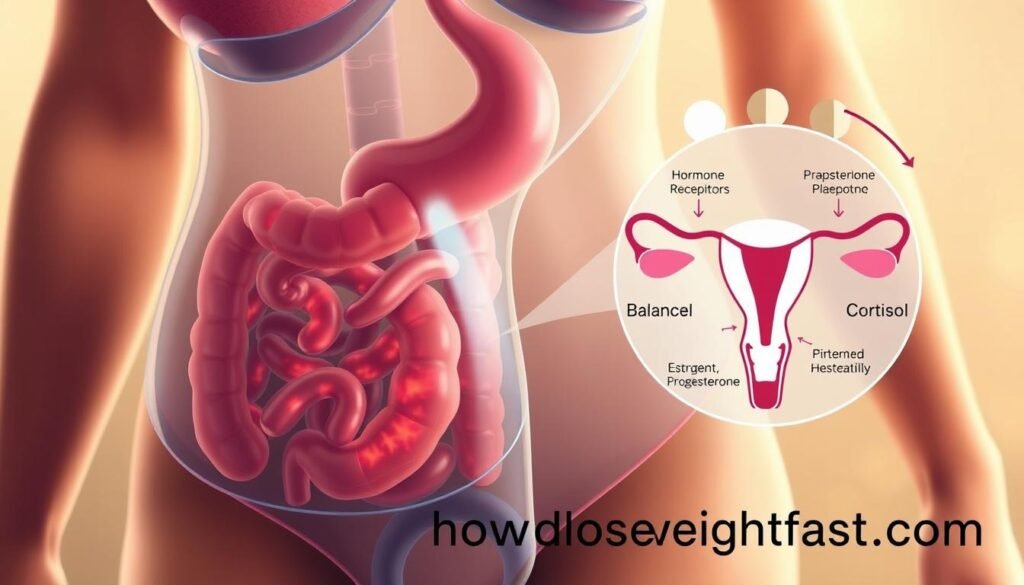Banish Bloat & Shed Pounds: Your Guide to Fast Weight Loss
Imagine slipping into your favorite jeans only to find the waistband digging into your stomach. That’s what happened to Sarah, a busy mom who noticed her energy dropping as her midsection expanded. Her mornings started with a puffy face and a belly that felt like a balloon. Sound familiar?
Bloating isn’t just about tight clothes. Excess gas and fluid retention can make your midsection look larger while causing discomfort. Recent weight changes often settle in the abdomen first, crowding your digestive organs. This creates a cycle where even small indulgences leave you feeling sluggish.
But there’s good news. Understanding the link between bloating and your body’s responses helps break this pattern. Simple adjustments to meals, hydration, and movement can create noticeable changes. You’ll learn why certain habits trigger that swollen feeling and how to replace them with solutions that work.
Key Takeaways
- Bloating often results from gas buildup and fluid retention, making your stomach appear larger.
- Weight changes in the midsection can reduce space for digestion, worsening discomfort.
- Immediate relief starts with identifying foods and habits that trigger bloating.
- Combining dietary tweaks with activity supports both bloat reduction and weight goals.
- Long-term success comes from addressing root causes rather than quick fixes.
Understanding Bloating: Causes & Symptoms
That post-lunch puffiness isn’t just in your head—it’s science. Your gut acts like a chemistry lab, where trillions of bacteria work to break down food. When this process goes sideways, you’ll feel it long before you step on a scale.
Gas and Fermentation in Your Gut
Gas forms naturally during digestion, but excessive amounts signal trouble. Your bacteria ferment undigested carbs—like those in beans or bread—creating carbon dioxide and hydrogen. This explains why some meals leave you feeling like a human balloon.
| Gas Source | Common Foods | Resulting Symptom |
|---|---|---|
| Lactose | Milk, Ice Cream | Abdominal Pressure |
| Fructose | Apples, Soda | Distended Stomach |
| Oligosaccharides | Broccoli, Lentils | Excessive Burping |
“Carbohydrate malabsorption is like leaving a soda bottle uncapped—those gases need somewhere to go.”
Digestive Contents and Constipation Challenges
When waste moves too slowly through your digestive tract, everything backs up. Constipation stretches intestinal walls, creating that familiar “stuffed” feeling. This traffic jam also gives bacteria extra time to produce gas, doubling the discomfort.
Early symptoms often include tightness below the ribs or irregular bathroom trips. Spotting these signs helps you act before the bloat becomes unbearable.
Identifying Trigger Foods and Intolerances
Your favorite snack might be playing hide-and-seek with your digestion. Many people discover their food intolerances only after tracking patterns between meals and discomfort. Unlike allergies, these reactions often appear gradually, making them trickier to spot.
Recognizing Food Intolerances
Lactose intolerance affects nearly 65% of adults globally. When your body lacks enough lactase enzyme, dairy products like milk or ice cream ferment in your gut. This creates gas bubbles that push against intestinal walls.
Common signs include:
- Bloating within 2 hours of eating
- Rumbling sounds in your abdomen
- Unexpected fatigue after meals
Impact of FODMAPs and Dairy
FODMAPs are sneaky carbs found in everyday foods like apples, onions, and wheat. They draw water into your intestines and feed gas-producing bacteria. A low-FODMAP diet often brings relief within days.
| High-FODMAP Group | Examples | Safer Alternatives |
|---|---|---|
| Fructans | Garlic, Rye | Quinoa, Spinach |
| Lactose | Yogurt, Soft Cheese | Almond Milk, Hard Cheese |
| Polyols | Cauliflower, Mushrooms | Zucchini, Bell Peppers |
Start by eliminating suspect foods for 3 weeks, then reintroduce one at a time. Keep a symptom journal—you might find broccoli affects you more than ice cream!
How to Stop Bloating and Lose Weight Quickly
That uncomfortable fullness after eating isn’t just a nuisance—it’s your body signaling for change. Oversized portions crowd your digestive system, creating a traffic jam of solids and gases. Strategic changes to your meals can ease this pressure while supporting your wellness goals.
Portion Control and Nutrient Balance
Swapping three large meals for five smaller ones keeps your stomach from stretching like a overfilled balloon. This approach reduces gas buildup while maintaining steady energy levels. Nutrition experts at Northwestern Medicine suggest using palm-sized portions of proteins with fist-sized veggie servings.
Limit salty snacks and fried foods—they’re double trouble. Sodium encourages water retention, while heavy fats slow digestion. Try roasted almonds instead of chips, or baked salmon rather than greasy takeout.
Water and Fiber: Your Digestive Allies
Fiber acts like a broom for your gut, but only when paired with enough water. Start with 5 extra grams of fiber weekly—think raspberries instead of bananas, or quinoa rather than white rice. Pair each fiber-rich snack with a glass of water to keep things moving smoothly.
| Daily Goal | Smart Swap | Benefit |
|---|---|---|
| 25g Fiber | Chia seeds in yogurt | Reduces constipation |
| 8 Cups Water | Herbal tea counts | Softens stool |
| Low Sodium | Fresh herbs vs salt | Decreases puffiness |
Remember—your gut loves consistency. Sudden changes shock the system, while gradual adjustments help prevent digestive fireworks. Track your progress in a food journal to spot patterns and celebrate small wins!
Lifestyle Adjustments for a Healthier Digestive System
Your daily habits hold surprising power over your gut’s efficiency. Small tweaks to movement patterns and meal routines can transform your stomach from a pressure cooker into a well-oiled machine.

Move Your Body, Soothe Your Gut
Light physical activity acts like a massage for your system. A 15-minute walk after meals stimulates natural contractions in intestinal muscles. This helps move trapped gas and stool through your digestive tract.
Try these yoga poses when discomfort strikes:
- Child’s Pose: Knees wide, torso folded forward—gentle pressure releases lower abdominal tension
- Happy Baby: Lying on your back, grab your feet—opens hips and encourages gas expulsion
- Seated Twist: Rotate torso while seated—massages internal organs
Calm Mind, Happy Belly
Chronic stress tightens digestive muscles like a clenched fist. Deep breathing exercises before meals activate your parasympathetic nervous system. This “rest and digest” mode optimizes nutrient absorption.
Mindful eating prevents swallowing excess air—a common bloating culprit. Follow these steps:
- Put down utensils between bites
- Chew each mouthful 15-20 times
- Avoid talking while chewing
“Consistent movement paired with conscious eating creates harmony between body and mind.”
Many people find combining these strategies boosts results. Track changes in energy levels and bathroom regularity—they’re key indicators your system is responding.
Natural Remedies and Supplements for Bloating Relief
Nature’s pharmacy offers surprising solutions for digestive discomfort. These approaches work with your gut rather than against it, providing relief without harsh chemicals. Let’s explore science-backed options that address both symptoms and root causes.
Peppermint Power and Plant-Based Helpers
Peppermint oil capsules act like traffic controllers for your intestinal tract. They relax cramped muscles, letting gas and waste flow smoothly. A 2016 trial showed 72% of IBS patients reduced pain using 180mg capsules three times daily.
Essential oils like fennel or ginger may also calm your abdomen. Always consult your doctor before trying new products—what works for others might not suit your system.
Hands-On Healing and Microbial Support
Massage your belly clockwise, tracing your large intestine’s path. This gentle pressure encourages trapped air to exit while stimulating bowel movements. Pair this with probiotic supplements containing Lactobacillus strains for best results.
- Choose refrigerated products with 10+ billion CFUs
- Start with one strain before mixing cultures
- Track changes in gas patterns for 3 weeks
“Natural remedies shine when used consistently—they’re marathon runners, not sprinters.”
These methods work best alongside dietary changes. Monitor your gut reactions carefully, adjusting approaches as your bacteria balance improves.
Managing Hormonal and Digestive Health
Did you know 75% of women report abdominal swelling during their menstrual cycle? Your body experiences natural hormonal tides that directly influence digestion and fluid balance. These shifts explain why your favorite jeans might fit perfectly one week but feel restrictive the next.

The Role of Hormones in Bloating
Estrogen and progesterone act like conductors in your digestive orchestra. When estrogen peaks before menstruation, it prompts water retention—like squeezing a soaked sponge. Progesterone’s decline during this phase slows intestinal movement, creating a double whammy of puffiness and backup.
Common patterns emerge:
- Mid-cycle estrogen surges correlate with swollen ankles
- Progesterone drops around menstruation lead to constipation
- Perimenopause fluctuations cause unpredictable symptoms
| Hormonal Phase | Bloating Trigger | Management Tip |
|---|---|---|
| Menstrual | Progesterone withdrawal | Increase magnesium intake |
| Perimenopause | Erratic estrogen levels | Track fluid retention patterns |
| Estrogen Dominance | Excess water retention | Reduce processed soy products |
“Hormonal bloating often follows predictable patterns—tracking three cycles reveals your personal rhythm.”
Your body becomes more sensitive to normal gas volumes during hormonal shifts. What feels like extreme pressure might be standard digestion amplified by progesterone’s muscle-relaxing effects. Over several weeks, dietary adjustments and stress management can recalibrate this sensitivity.
For chronic conditions like PCOS, work with your doctor to balance hormones. Many people find evening primrose oil or vitamin B6 helps manage cyclical symptoms within 6-8 weeks.
Quick Fixes and Long-Term Prevention Strategies
Your abdomen feels like an overinflated balloon—here’s how to deflate it fast. Simple actions can ease discomfort within minutes, while smarter habits build lasting digestive resilience.
Tips for Immediate Bloating Relief
A 10-minute walk jumpstarts intestinal contractions, pushing trapped air through your bowel. Simethicone capsules break gas bubbles into smaller pieces, making them easier to pass. These work best when taken before meals if you know trigger foods are coming.
Warm baths relax cramped muscles while lowering stress hormones. Add Epsom salts to draw out excess fluid causing puffiness. For sudden constipation, try massaging your lower abdomen in clockwise circles.
Sustainable Changes for Weight Loss Success
Chronic gas bloating often signals deeper issues like irritable bowel syndrome. Track symptoms for three weeks—patterns reveal whether IBS or food sensitivities need attention. Replace processed snacks with fiber-rich alternatives to support regular bowel movements.
| Approach | Action | Benefit |
|---|---|---|
| Short-Term | Peppermint tea after meals | Relaxes digestive muscles |
| Long-Term | Daily probiotic regimen | Balances gut bacteria |
| Preventive | Stress-reduction techniques | Reduces inflammation |
“Persistent bloating with weight changes warrants medical insight—don’t dismiss recurring symptoms.”
Seek medical guidance if you experience blood in stool or unexplained weight loss. These could indicate disease processes needing professional care. Most find combining quick fixes with dietary tweaks may help achieve both comfort and fitness goals.
Conclusion
Your journey to lasting abdominal comfort begins with curiosity. Every body speaks through subtle cues—tightness after meals, energy dips, or unexpected puffiness. Learning this language transforms discomfort into actionable insights.
True progress lies in personalization. What works for your friend might backfire in your gut. Track patterns diligently, celebrate small victories, and adjust strategies as your system evolves. Remember, consistency beats intensity when building sustainable habits.
Pair smart food choices with mindful movement and stress management. These pillars support both digestive health and overall vitality. If setbacks occur, view them as feedback—not failure—to refine your approach.
Your wellness journey thrives on patience and self-compassion. Trust gradual changes over quick fixes, and consult professionals when needed. With each mindful choice, you’re rewriting your body’s story—one comfortable day at a time.
FAQ
Can certain foods worsen bloating even if I don’t have an intolerance?
Yes! High-FODMAP foods like onions, garlic, and beans can ferment in your gut, causing gas and discomfort. Processed snacks, carbonated drinks, and artificial sweeteners like sorbitol may also trigger symptoms. Keeping a food diary helps identify sneaky culprits.
Does drinking water actually help reduce bloating?
Absolutely. Staying hydrated supports digestion, prevents constipation, and flushes excess sodium. Try adding lemon or cucumber for extra anti-bloat benefits. Avoid gulping—sipping slowly prevents swallowing air, which can worsen gas.
How does stress contribute to bloating and weight gain?
Stress slows digestion, leading to constipation and trapped gas. It also spikes cortisol, a hormone linked to belly fat. Practices like yoga, deep breathing, or even a 10-minute walk can calm your nervous system and improve gut motility.
Are probiotics safe for long-term bloating relief?
Probiotics like Culturelle or Renew Life can rebalance gut bacteria, but results vary. Start with low doses and monitor symptoms. For some, fermented foods like kimchi or kefir work better. Consult a doctor if bloating persists beyond two weeks.
Can lactose intolerance develop suddenly in adulthood?
Yes—many people lose lactase enzymes as they age. If dairy causes cramps or gas, try lactose-free alternatives like Lactaid or Fairlife. For severe cases, a hydrogen breath test can confirm intolerance.
Does peppermint oil really work for IBS-related bloating?
Studies show enteric-coated peppermint oil (like IBGard) relaxes intestinal muscles, easing spasms and gas. Pair it with a low-FODMAP diet for best results. Avoid it if you have GERD, as it may worsen acid reflux.
How quickly can lifestyle changes reduce bloating?
Simple swaps like chewing slowly, avoiding straws, and opting for smaller meals can bring relief in days. For lasting weight loss, combine these habits with consistent exercise and whole-food choices like leafy greens or lean proteins.
Are over-the-counter supplements effective for bloating?
Enzymes like Beano break down hard-to-digest carbs, while simethicone (Gas-X) disperses gas bubbles. Psyllium husk (Metamucil) aids regularity but start low to avoid initial gas. Always check with a doctor for chronic issues.
Can hormonal shifts cause persistent bloating?
Yes—estrogen fluctuations during menstruation or perimenopause often lead to water retention and slower digestion. Magnesium-rich foods (spinach, almonds) or supplements like Natural Calm may ease these symptoms.
What’s the link between constipation and weight plateaus?
Constipation adds temporary water weight and slows metabolism. Increase fiber gradually with chia seeds or oats, and pair with electrolytes. If issues persist, consider gentle laxatives like MiraLAX or consult a gastroenterologist.
Related Posts

Thyroid-Friendly Weight Loss: Proven Strategies
